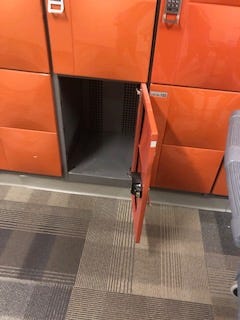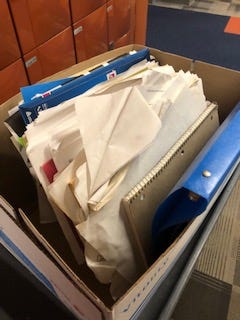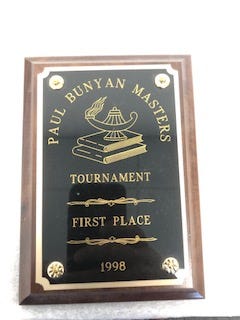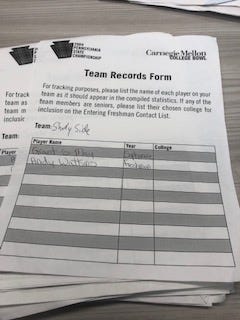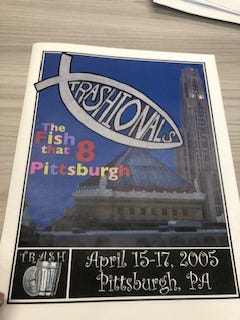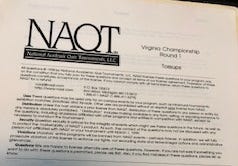In 2016, my office moved to a new building. This was both an attempt to put our employees in one building, and a way to reset the 20-year tax break the old office had gotten the company. One of the features of the building was a pair of hallways along the length which had three-high stacks of lockers. It was a design choice to have us possibly be an office with modular unassigned seating, but it never really worked out that way. On the first day in the office, I took a stack of items from a box that I had packed up without much thought, and was blocking me from using the mouse, and dumped it into the locker.
About a year after I moved into the second floor, I got moved to another team with most of the developers in our international offices, and I was moved to the third floor with the other testers. What was not moved was my locker. I left the locker untouched except for two or three times when I slid a pile of papers in that I wasn’t needing to look at. Nothing in this locker seemed immediately essential, and so there was never a need to go down a floor and pull anything out. Then I got sick, and while I was off of work, I was moved to my fancy new office next door, and when I got back, there were a stack of boxes sitting here for me to unpack. It was only a few months later that I realized that they never moved anything out of the locker, because at that point, nobody realized I still had one, and new employees weren’t getting available lockers. Then COVID hit, and no one was allowed back into any offices, then only in your own office, and then finally some normalization in 2022.
This summer, I received instructions that my locker was going to be closed up and I needed to come into the office, and take the stuff. I was given a more insistent instruction last week. On Friday, while my weekend tasks were beginning their run, I used my passcard to go up to the second floor for the first time in years, and unlocked the vault. What would we find in this vault? Maybe gold, maybe even dead bodies.
What was in the vault:
- My textbooks and notebooks for courses on AI, metal forming, linear algebra, and materials science. I say textbooks, but in true Cornell just before the internet took over fashion, these are paper copies, three-hole-punched of the professor's textbook to be published, when he gets done with the remaining sections that no instructor will ever get to. I realize this was how textbooks worked back then, but I suddenly felt seen.
- A half ream of orange copy paper and a half ream of fluorescent green copy paper, from my misspent youth traveling to education conferences handing out information about quiz bowl. I traveled to educational conferences and sat next to vendors advertising signage, supplemental textbooks, and charity drives that you could bring to campus. It was always an eclectic mix of people usually ignored by the attendees. Having no use for it now, I’ve offered it to Catie to put together flyers for the team at Seton.
- A few print copies of websites which have long since departed. I had clearly sifted through these papers once before because the print jobs were just of the first printed page of a webpage. That wouldn't seem like much, but if I spent the time doing that, I must have checked whether the page was archived by web.archive.org. If the webpage was archived, I would be able to review the whole page from just the link printed in the header of the printed page. This evening, I’ll be looking through the pages to see if web.archive.org kept its promise.
- A plaque from the 1998 Minnesota Masters tournament. Notable only because I won this on the weekend after I was hired at Ansys, and I flew back and immediately went to work Monday morning. The plaque went in the desk, and has only appeared sproadically since. This kind of reflects the history of prizes in quiz bowl competition. Once you leave school, and the promotional value of a trophy goes away, the most useful prizes you can get are probably not prizes. The things I've actually used that came from tournaments is a short list. During college, I won a shot glass at Dartmouth's tournament, which has stayed with me (more because of the thickness of the glass than anything else.) I've won some books which were useful and which I kept, but most of those that were once useful, I have regifted as prizes to smaller tournaments. And counterintuitively, after a plumbing accident in my guest bathroom, I got the most use out of a toilet seat which was the championship trophy of a Trashmasters tournament.
- The roster sheets of numerous Pittsburgh-area tournaments, kept only because I usually needed them a few months after the tournament to add to the freshman contact lists. Mentioned only because I found this and I needed something to make this special seem more disreputable.
- The program for Trashionals 8, held at the Cathedral of Learning in 2005. As much as time was wasted finding trophies for tournaments, there was probably much more time that ended up mostly wasted on team guides for nationals. Not that they’re not useful, it’s just that they are something very much of the time, when teams at nationals weren’t as connected to each other, and could use an introduction. If these ever come back, whoever does the first one should turn it into a template, and automate the entire publication.
- The last extant copy of an anomaly. In a beat-up old manila folder, with yellowing pages, was a 40 page pack of NAQT questions, in the wrong fonts, labeled "Virginia State Championships". This was the equivalent of finding the recipe card the Colonel's Secret Recipe was written on, or an episode of "Doctor Who" from the 1960's that the BBC had wiped before knowing the value of reruns. Because it was undated, had writer numbers prefacing the question number, and didn't use Palatino/Book Antiqua, it had to be from the first year of NAQT. Most of the material from that year existed only on paper, because there was a transfer error with the software in the late 2000's. So I was probably looking at the only copy of this still in existence. When I checked with people closer to the database they confirmed there was no record of the contents of this set, just that it had 388 tossups in one round.
Now before you call that out, remember that this locker was last opened in 2017, well before the decision to shift to electronic copies, and that I was authorized to keep it prior to that because I had been an editor at that time. If I were to make a guess, this was a print to be second eyes editor over the questions, check that power marks were not present, and that all the print conversions done to customize this job were working properly.
It's being shipped back to be scanned and the questions entered into the database after 25 years. And that is the only thing that kept me from getting tequila drunk afterwards.
When I started out writing this, I ended up confused how this wasn’t all over the internet. I couldn’t find any trace of the 1986 special featuring Geraldo Rivera. After a few minutes I realized I was suffering some kind of Mandela Effect, because I was searching for “The Secret of Al Capone’s Vaults” and not “The Mystery of Al Capone’s Vaults.”
I had always thought of quiz bowl as a natural defense against the Mandela Effect, after all the very pedantic nature of exact titles that quiz bowl relies on keeping the exact title in memory, and if you screw it up once, the negative points reinforcement ensures you’ll remember it in future. But in this case, I think I was broken of this well before I ever encountered quiz bowl. My father found this hilarious when we watched it live, and when it became a joke from late night television on, it was always referred to loosely, people made the mistake live on TV but nobody corrected them. And so when it became the family joke for any sort of appearance of Geraldo Rivera, or a box in the attic, we would stick any appropriate piece in front of “Al Capone’s Vault” turning it singular and further moving it further away from the exact title.
Today, if they were asking about this, the answer line would bypass all of this, and go for either Al Capone’s vault, or more likely Al Capone, or Geraldo Rivera. I don’t know if it would be asked about today, but it probably is worth study, as it was a turning point in the media’s ability to fill time when nothing is actually happening. Once you have that, you can put a column like this together on nothing but an a box of papers.


